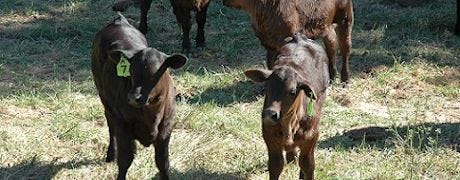March 19, 2014

Spring calving time is almost here for many beef producers in the state. In an effort to make this spring calving season a success, University of Missouri livestock Specialist Gene Schmitz offers six tips for producers to consider this time of year:
• Time feeding for calf delivery. Time of beef cow feeding has been shown to influence the time of day when calves are born. Beef cows fed at dusk or later tend to calve during the daylight hours. Altering the time of feeding as soon as one week prior to calving has been shown to affect the time of day that cows calve. Limiting hay access to 12 hours per day is an easy way to implement a nighttime feeding program.

CUTE CALVES: Beef producers are ready to see pastures full of calves this spring. With current cattle prices it pays to plan for a successful spring calving season.
• Be prepared to assist new heifers. Know when to intervene to help beef cows and heifers with the calving process. Once the calving process begins, watch for signs of progress with delivery. If no progress is noticed after 30 minutes, intervention is warranted. Determine what the problem is and if it can be handled without additional expertise. Don't wait too long to call for veterinary assistance. Dead calves don't pay many bills.
Limiting Stress: Best Practices for a Successful Calving Season
For a majority of beef cattle producers, spring is calving season. That means a busy time, especially with weather challenges. Planning for all possibilities is the best way to prepare for a successful calving season. Download our free report: Best Practices for a Successful Calving Season
• Provide shelter during cold weather. If the weather is bad, provide a place to warm calves. Keep these areas clean and dry to prevent disease problems.
• Segregate to prevent scours. Segregate older calves from calves less than a week old. This greatly reduces scour causing pathogen transfer from older calves to younger calves.
• Write down calf birthdates. This data can be used to track reproductive efficiency, used in the replacement heifer selection process, and helps in many other management areas.
• Monitor feed of lactating beef cows. Much of the distiller's grains are now being de-oiled at the ethanol plants. This reduces the energy content of the distiller's grains. Rations may need to be adjusted to account for this decrease in energy.
Source: University of Missouri Extension
You May Also Like




